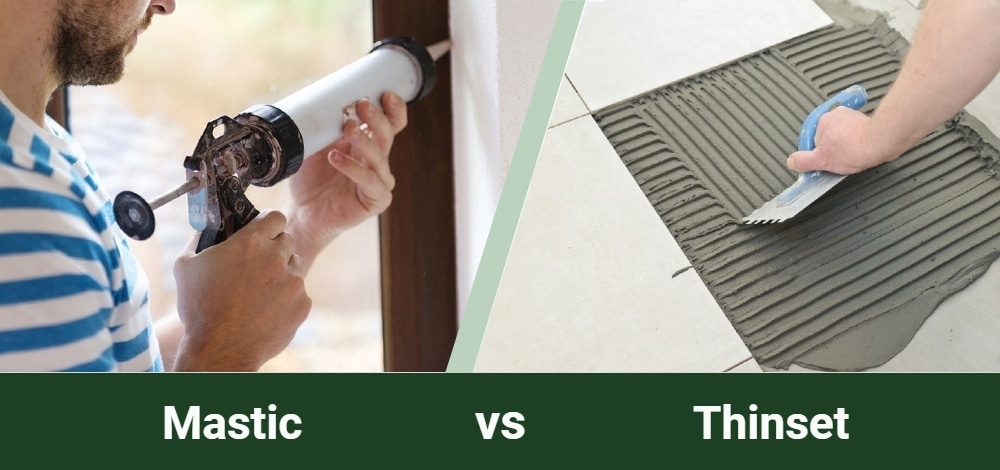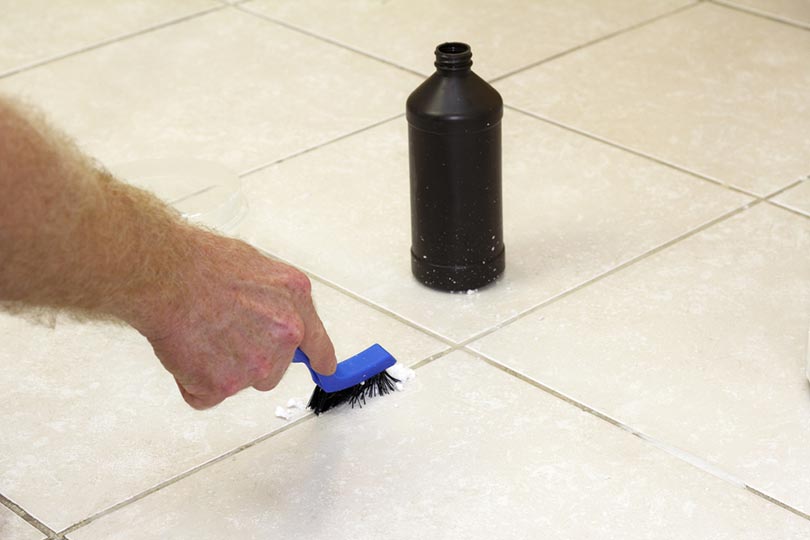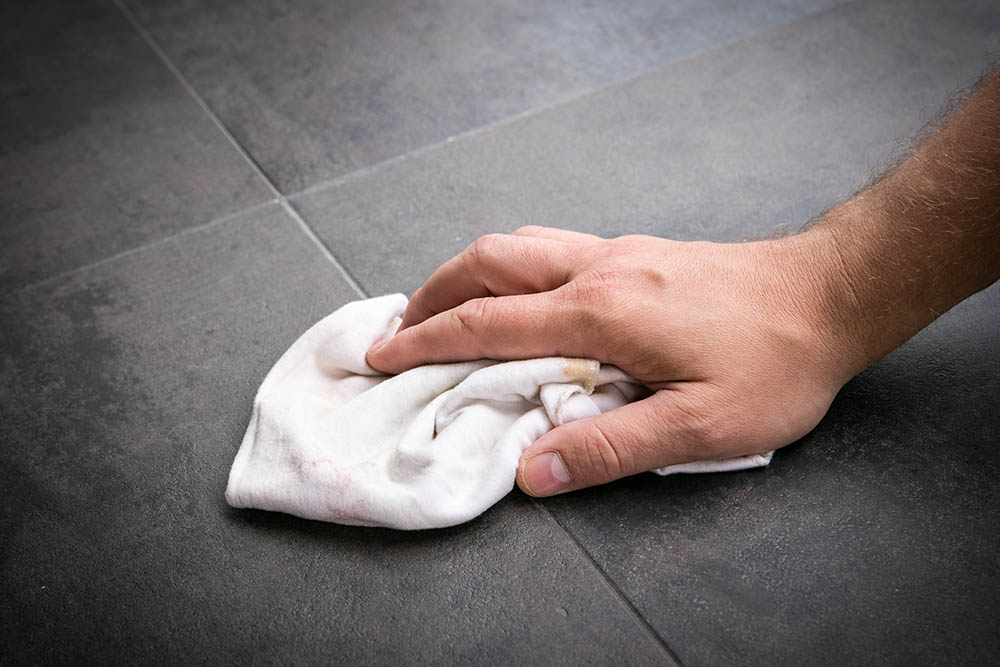Mastic vs Thinset: Differences & Uses Explained
-
Jeff Weishaupt
- Last updated:

When choosing the best adhesive or sealant for construction projects, it’s often hard to decide which product is the best fit. For example, mastic and thinset are two of the most popular adhesives on the market, but they have very different properties and uses. Which one is the better option?
How do you choose between the two? Do they both have the same applications and benefits? Let’s find out.
Click Below to Jump Ahead:
Overview of Mastic
Mastic is a tile adhesive for ceramic tiles, natural stones, and mosaics. It is a water-based adhesive used in interior and exterior applications. Mastic has a low VOC content and is easy to apply with a trowel or roller. It also resists mold and mildew growth.
Mastic comprises Portland cement, sand, water, and other ingredients. It is a white or light gray color when dry. Mastic can be purchased in premixed containers or as a dry powder that must be mixed with water before use.
Where to Use It
Mastic has many applications in both indoor and outdoor settings. It can be used on walls, floors, countertops, backsplashes, and showers.
Mastic can also adhere ceramic, porcelain, and mosaic tiles to various surfaces, including drywall, plywood, fiberglass, and cement backer board.
Where Not to Use It
Mastic doesn’t do an excellent job of sealing and adhering to wet surfaces. It should not be used in constantly wet areas, such as baths and showers. It is also not recommended for use on floors subject to heavy traffic or abuse. Here are some areas where you should not use mastic:
- Around water features
- Steam rooms
- Shower rooms
- Swimming pools

How to Use It
Mastic is a water-based adhesive, so it is easy to apply with a trowel or roller. For best results, apply mastic to a clean, dry surface. The surface should also be free of dust, grease, and other contaminants.
Mixed mastic should be used within two hours of mixing. If it becomes too thick, add more water and mix again.
The placement of tiles should be planned before starting to apply mastic. It will help ensure that the tiles are laid out evenly and there is no wasted mastic.
Mastic should be applied to the back of each tile before setting it in place. Use a trowel to spread mastic evenly over the surface. For best results, let the sealant cure for 24 hours before grouting the joints between the tiles.
- Ideal for indoor use
- Can be used on a variety of surfaces
- Easy to apply
- Mold and mildew resistant
- Does not do a good job of sealing wet surfaces
- Not usable in high-traffic areas

Overview of Thinset
Thinset is a modified mortar made of Portland cement, silica sand, and water. It is often used to set tile or stone. Thinset is typically 3/8 inch thick and available in powder and premixed form.
Thinset mortar is a cementitious paste that bonds tiles or stone to a substrate. The additives in the thinset increase its bonding strength and thicken the mixture so that it can be spread easily.
Since thinset is thinner than other mortars, you can spread it uniformly across surfaces. However, when applying thicker mortars, there’s always a risk of the material piling up in some areas and not spreading evenly.
Thinset is also known for its high shear strength, which is the force required to break the bond between the mortar and the substrate. High shear strength is necessary because it ensures that your tile or stone won’t come loose over time.
- Unmodified: It is in its simplest form, meaning it doesn’t have additives.
- Modified: It has additives that increase its bonding strength and make it more durable. These additives include liquid latex polymers and acrylic. Some modified thinsets also have chemical-resistant agents to protect against water and staining.
While grout is visible, thinset is not ideal for applications where it will be visible. Instead, it should be hidden behind the tile. So, if you’re looking to set tile in a visible area, you should use another type of mortar, like mastic.
Where to Use It
You can use thinset both indoors and outdoors. It’s a versatile adhesive that can be used on many different surfaces, including:
- Concrete
- Brick
- Cinder block
- Plaster
- Drywall
- Wood
Thinset can also be used in wet areas like showers and tubs. Because it’s so versatile, you can use it for a variety of projects, including:
- Setting floor tile
- Setting wall tile
- Installing backsplashes
- Repairing cracked tiles
Where Not to Use It
Although thinset is a versatile adhesive, there are some surfaces where you should not use it. These include:
- Metals
- Glass
- Plastics

How to Use It
Now that you know where thinset is useful, let’s see how to use it. The first step is to prepare the surface. It involves cleaning it and ensuring there’s no loose paint, dirt, or debris. If setting tile on a concrete floor, you’ll also need to ensure the surface is level.
Once the surface is prepared, you can begin mixing the thinset. If you’re using the powder form, mix it with water according to the manufacturer’s instructions. If you’re using the premixed form, there’s no need to add water. Instead, pour it into a bucket and stir it until it’s smooth.
After mixing, you can begin spreading it on the surface. Use a notched trowel to apply an even layer of thinset over the area. Then, you can place your tile or stone on top of the thinset. Use a level to ensure the pieces are even and press them into place. Once all the tile is in place, let the thinset dry for at least 24 hours before grouting.
- Widely available
- Inexpensive
- Can be used indoors and outdoors
- Can be used on many different surfaces
- Bonds tile or stone securely
- High shear strength
- Not visually appealing
- May be too runny
- Inflexible
Mastic vs Thinset: Which Should You Choose?
The debate between mastic and thinset has been around for a while in the construction industry. Each type of mortar has pros and cons, and the option you choose will ultimately depend on the project. Besides being used for different purposes, mastic and thinset also differ in composition. So, you have to consider other factors before making a decision.
Size
The size of the tile you’re using is an essential factor. If you’re working with small tiles, mastic is the best option. Mastic is easy to spread and doesn’t require the precision that thinset does.
On the other hand, if you’re working with larger tiles, thinset is the way to go. Thinset is more forgiving when it comes to large tiles and will provide a more secure hold.

Composition
Mastic is made from asphalt and organic materials, while thinset is made from Portland cement, sand, and water. The organic materials in mastic make it more flexible, while the Portland cement in thinset makes it more durable.
Therefore, if you’re looking for a mortar that will give you a long-lasting hold, opt for thinset. Meanwhile, mastic will be a good choice if you need a mortar that can be easily removed.
Cost
Cost is always an essential factor to consider when choosing any construction material. For example, mastic is generally more expensive than thinset, but the cost difference is insignificant.
One advantage of mastic over thinset is that it doesn’t require a wet saw for installation. However, wet saws can be expensive to rent or purchase, so this is something to keep in mind if you’re on a tight budget.
Moisture
If you need an adhesive for a moisture-prone area, it’s always a good idea to use thinset. Since thinset is made from Portland cement, it’s more resistant to moisture than mastic.
Mastic can break down over time when exposed to moisture, so it’s not the best choice for bathrooms or kitchens. However, you may be able to use it on areas surrounding tubs and showers since they’re ‘intermittent’ moisture regions.
But, for the best results, it’s always best to use thinset in moisture-prone areas. You can use it in tiled swimming pools, shower pans, and backsplashes without any worries.

Substrates
Another factor you have to consider is the substrate. If you’re working with a porous substrate, mastic is the best choice. That is because mastic can penetrate porous substrates and create a stronger bond.
Meanwhile, if you’re working with a non-porous substrate, choose thinset. Thinset doesn’t need to penetrate the substrate to create a strong bond, so it’s ideal for use on non-porous surfaces.
Leveling Problems
Let us preface this by saying that thinset is not meant to be used as a leveler. However, it has ‘build’ properties, which means it can level up minor depressions in the substrate.
Mastic wouldn’t do the same because of its syrupy properties and lack of filling abilities. If you’ve ever worked with mastic, you will notice it has a consistency of pancake batter. That means it will just ‘run’ into any depression and not fill it up.
So, if you have minor leveling problems, thinset is the best option. Just note that you should only use it for minor depression. Anything more than that, and you’ll need a leveling compound, such as self-leveling concrete.
Checklist for Mastic vs. Thinset Usage
When installing ceramic tile, there are a few different materials you can use to set the tile. Mastic and thinset are two of the most popular options.
But it’s easy to be confused about when to use each one. Here’s a quick checklist to help you decide which product is best for your tile installation project:
- Shower Floors: Thinset
- Other Floors: Thinset
- Kitchen Backsplashes: Mastic
- Tub/Shower Walls: Thinset
- Floor Heating Systems: Thinset
- Walls: Mastic
- Bathroom Walls: Thinset
- Kitchen Countertops: Thinset
As a rule of thumb, thinset should be used for floors, walls in showers and tubs, and any other areas where there will be a lot of water or moisture. On the other hand, mastic is a good choice for backsplashes and other wall projects where there won’t be as much exposure to water.
| Mastic | Thinset | |
| Moisture Factor | Usable in dry and damp areas only | Usable in moisture-prone areas, even places fully submerged in water |
| Best Areas | Walls, dry backsplashes, and wainscots | Bathrooms, showers, tubs, and backsplashes |
| Setting Power | Sets quickly | Sets slowly |
| Vertical Application | Best for it | Better for leveling depressions |
In Conclusion
By now, you should know when to use mastic and when to opt for thinset. The choice will depend on your project type, cost, moisture exposure, and substrate.
While mastic is an excellent all-purpose tile adhesive, thinset should be your go-to for most moisture-prone projects. It’s incredibly well-suited for outdoor applications or areas that will see a lot of water, such as bathrooms.
- https://www.county.construction/mastic-sealant-help/mastic-sealants-quick-guide/
- https://www.designingbuildings.co.uk/wiki/Mastic_sealant#:~:text=Mastic%20can%20be%20used%20outside,enough%20to%20accommodate%20large%20movements
- https://gtsealants.co.uk/blog/what-is-mastic-sealant/
- https://mtcopeland.com/blog/what-is-thinset-advantages-and-disadvantages/
- https://www.tileoutlets.com/blog/what-you-need-to-know-about-thinset-or-mortar/
- https://www.tiletools.com/blogs/news/mastic-vs-thinset-which-should-i-use
Featured Image Credit: (L) Halfpoint, Shutterstock | (R) DUO Studio, Shutterstock
Contents
